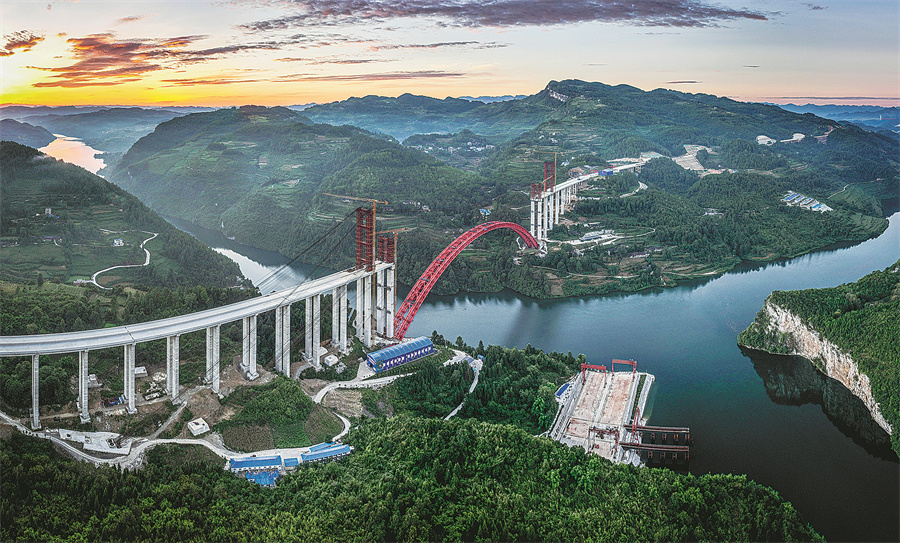China offers lessons on becoming modernized


Development is a journey with no end, only new beginnings. Recognizing this, China has adopted the approach of focusing on the future, not the past, and is striving tirelessly for modernization.
To understand the country's road to modernization, one must examine China's governance, culture, history, norms and policies. Many nations face challenges in adopting modernization, but China's progress under the leadership of President Xi Jinping has brought many key achievements over the past decade.
Modernization refers to the process of transforming a traditional or less economically developed society into a modern industrialized society. In this process, there have been three stages for China: early, revolutionary and reform. There are different aspects to each stage.
In the first stage, the goal was to win national independence. The second stage was to establish a new State system, promote national economic recovery and economic industrialization, and create a new identity. In the third stage, the main goal has been to create a pragmatic development concept, taking into account specific national conditions, and the revival of the national spirit of the Chinese people.
Internal reforms and robust plans have enabled the country to transform itself from a highly centralized planned economy into a socialist market economy full of vitality, and from a largely closed country to one that is open to the world on all fronts.
China also made huge progress in becoming the world's second-largest economy, and it achieved a historic transformation by raising the living standards of its people from bare subsistence to general, moderate prosperity. These achievements have fueled the push toward modernization and national rejuvenation by providing robust institutional conditions and the material base for rapid development.
With today's evolving socioeconomic and political parameters, the world has been experiencing profound changes. Over the past few decades, economic modernization has contributed greatly to global growth and broader cooperation. Indeed, it has become an irreversible trend, but in light of international developments, modernization has also faced many challenges in some developing countries, including China. Nonetheless, China has become a role model for other countries to achieve modernization. As part of the broader modernization of the Global South, China has added substance to it in the form of socialism with Chinese characteristics.
Building a modern socialist country in an "all-around way" has been upheld and improved with the system of socialism with Chinese characteristics, which has effectively modernized China's system and capacity for governance.
As China innovates at a faster pace and achieves high-quality growth, new strategies and robust plans will continue to emerge for wider cooperation. This will lead to the creation of a much more powerful structure, and balanced development with a ripple effect, which will offer countries more opportunities with a shared, forward-looking spirit.
In addition, China's soft power has contributed much to the success of its modernization endeavors. The Chinese nation has enormous soft power assets because of its great civilization, cultural heritage, modern vision and insistence on cooperation. These have all contributed to its grand transformation and economic growth.
Great visions are simple and pure, but they require actions. China has implemented sound policies and practical plans. These are the key to its modernization and to the realization of a community with a shared future. Undoubtedly, a new era calls for a new vision, which in turn needs great wisdom. New impetus, new visions and new aspirations are the determinants of future cooperation and joint ventures. Thus, certain decisions and actions will pave the way for the modernization for other countries vis-a-vis the Chinese pathway toward rejuvenation.
The modernization of China represents profound changes in its economy, politics, culture and society. These changes do not mean the rejection of what went before, but rather the embracing of changing times. Moving with the trend of the times, the Chinese miracle of rapid modernization has impressed the world.
Western countries, especially the United States, should learn from the Chinese model of governance and its modernization strategies rather than indulging in hostile propaganda and confrontation. The US government has always created obstacles for developing countries on their journeys toward openness and inclusive development. Economic sanctions, racial discrimination, flawed and unfair laws, and intervention in other states' affairs are the norms of US behavior.
However, all these provocative actions demonstrate the US' vicious agenda of creating divisions. The US should abandon the outdated notions of confrontation and containment and learn from China how to become a modernized society.
The author is executive director of the Islamabad-based Pakistan Research Center for a Community with Shared Future. The views do not necessarily reflect those of China Daily.
- Beijing witnesses snowfall
- Tongji University's Wu Jiang assumes presidency of architects' Asia council
- PLA carries out drone training operations near Dongsha Islands
- PLA monitors US naval vessels transiting the Taiwan Strait
- Losar warmth in a new home
- New carrier rocket built by Beijing company fails in maiden flight




































